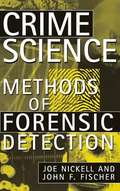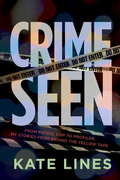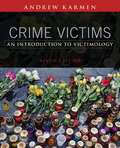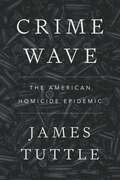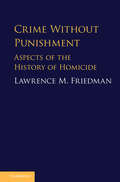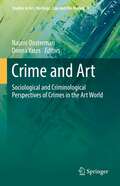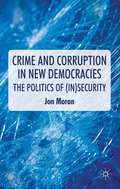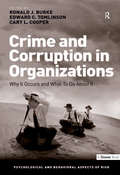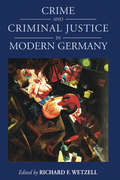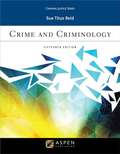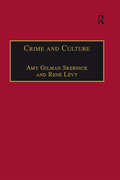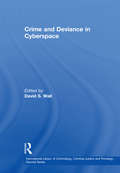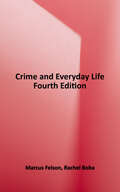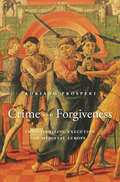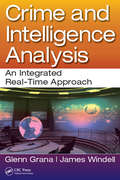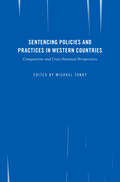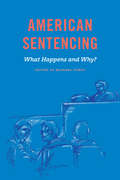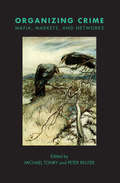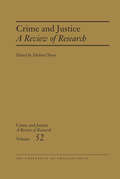- Table View
- List View
Crime Science: Methods of Crime Detection
by Joe Nickell John F. FischThis method is empirical (from the Latin empiricus, "experienced"), meaning that knowledge is gained from direct observation.
Crime Seen
by Kate LinesA criminal profiler, trained at Quantico, former Chief Superintendent of the Ontario Provincial Police (OPP) Kate Lines recounts her remarkable story using pivotal cases she worked on in the course of her career. How does a farm girl from Ennismore enter a male-dominated field and become a top criminal profiler and groundbreaking leader? For Kate Lines, it started humbly, patrolling highways. She learned quickly that the best way to thrive was to keep calm, carry on and never lose her sense of humour. In what would be the first of many dramatic turns in her career, Kate traded in her uniform for a tight miniskirt and a leather jacket, becoming one of the OPP's first female undercover officers. In 1990 came the opportunity of a lifetime: to be chosen as the 2nd-ever Canadian in an elite program at Quantico, Virginia in what was then the emerging field of criminal profiling. After 10 months of an intensive education in the intricacies of violent crime, Kate's new skills made her much in demand back home. Over the years she was involved in a number of high-profile cases, such as the abduction and murder of Kristen French and of Tori Stafford and the disappearance of Michael Dunahee. Kate was an early proponent of ViCLAS--the Violent Crime Linkage Analysis System, and when she took charge of the new and massive Behavioural Sciences division in Orillia, she took over ViCLAS and turned the department into a hub of innovation. Kate was awarded a Governor General's medal for being in the top 1/10th of 1% of the members of police forces that year. The following year the Canadian Police Leadership Foundation named her Police Leader of the Year. Always taking care not to aggrandize in any way the criminals whose names we may know all too well, Kate feels it's much more important to focus on the courage of victims and their families. Kate is an unsung, groundbreaking Canadian woman, one of a kind in this country, with a unique, inspiring and fascinating story to share.
Crime Victim Rights and Remedies 2nd edition
by Peggy M. Tobolowsky Mario T. Gaboury Arrick L. Jackson Ashley G. BlackburnThe authors describe the constitutional and legislative provisions addressing the principal crime victim rights and remedies and leading judicial opinions that have interpreted them. In addition to presenting the current state of law in this area, the text describes the status of implementation of these rights and remedies, relevant empirical research, and a sampling of the pertinent policy analysis. This comprehensive portrait of the past and current status of crime victims rights and remedies in this country will inform the continued evolution of law and practice in this area. The second edition of Crime Victim Rights and Remedies will continue to address the evolution of key crime victim rights (e. g. , the rights to notice of and to be present and heard at criminal justice proceedings) and will include the state constitutional amendments, legislation, court decisions, and empirical studies completed since the first edition in 2001. Of particular note will be an expanded federal section regarding each right and remedy reflecting the Crime Victims' Rights Act, enacted in 2004, and court decisions that have interpreted it thus far.
Crime Victims: An Introduction To Victimology (Ninth Edition)
by Andrew KarmenA first in the field when initially published and now a true classic, CRIME VICTIMS: AN INTRODUCTION TO VICTIMOLOGY, Ninth Edition offers the most comprehensive and balanced exploration of victimology available today. The author examines the victims' plight, carefully placing statistics from the FBI's Uniform Crime Report and Bureau of Justice Statistics National Crime Victimization Survey in context. At the same time, he "humanizes" victims' stories through compelling case studies. The text systematically investigates how victims are currently handled by the criminal justice system, analyzes the goals of the victims' rights movement, and discusses what the future is likely to hold. This Ninth Edition presents current coverage of the seriousness of intimate partner violence, child abuse, sexual assaults in the U. S. military, acquaintance rapes on college campuses, shootings on campuses, whether arming for self-protection is an effective strategy, and similar high-profile issues. It also includes new information about "survivorology" and "bystanderology" as well as new material on practical issues facing victims.
Crime Wave: The American Homicide Epidemic
by James TuttleWhy homicides have increasedThe homicide rate in the United States increased by approximately 55 percent from 2014 to 2021. An initial spike in homicide rates began in 2015, and the rate continued on its generally upward trajectory through subsequent years, eventually increasing by the largest annual margin in recorded history during 2020. By 2021, several cities and states recorded homicide rates higher than during the crime-plagued 1990s. Why did America suddenly become more violent?James Tuttle examines the underlying causes behind this surge in violence, arguing that it is the result of the decline in American well-being, a growing distrust in institutions, an increase in alcohol and drug abuse, and escalating firearm sales. Tuttle also shows how the homicide epidemic has hit different parts of the country; notably there has been an increase in homicide in the Midwest that is 25 percent greater than in the rest of the country.Through comprehensive analysis of the most recent crime data available, Tuttle provides compelling evidence supporting these contentions, illuminating the intricate relationship between societal decline and the homicide epidemic. This book builds on evidence that demonstrates the limited impact of police tactics on crime rates, and finds little substantiation for the notion that police department defunding played a role in the rise of crime across American cities. Crime Wave attempts to reframe the public debate beyond the current “police-only” paradigm of explaining crime trends by examining the broader social and cultural forces that shape American violence.
Crime Without Punishment: Aspects Of The History Of Homicide
by Lawrence M. FriedmanIn this compelling book, Lawrence M. Friedman looks at situations where killing is condemned by law but not by social norms and, therefore, is rarely punished. <P><P>He shows how penal codes categorize homicides by degree of intent, which are in turn based on society's sense of moral outrage. Despite being officially defined as murder, many homicides have historically gone unpunished. Friedman looks at early vigilante justice, crimes of passion, murder of necessity, mercy killings, and assisted suicides. In his explorations of these unpunished homicides, Friedman probes what these circumstances tell us about conflicts in social and cultural norms and the interaction of law and society.<P> Asks when, if ever, killing can justifiably be considered as homicide.<P> Connects seemingly different examples of 'crimes without punishment' with historical developments.<P> Links research on the history of criminal justice with the way in which legal systems actually operate in society today.
Crime and Art: Sociological and Criminological Perspectives of Crimes in the Art World (Studies in Art, Heritage, Law and the Market #1)
by Donna Yates Naomi OostermanThis volume brings together work by authors who draw upon sociological and criminological methods, theory, and frameworks, to produce research that pushes boundaries, considers new questions, and reshape the existing understanding of "art crimes", with a strong emphasis on methodological innovation and novel theory application. Criminologists and sociologists are poorly represented in academic discourse on art and culture related crimes. However, to understand topics like theft, security, trafficking, forgery, vandalism, offender motivation, the efficacy of and results of policy interventions, and the effects art crimes have on communities, we must develop the theoretical and methodological models we use for analyses. The readership of this book is expected to include academics, researchers, and practitioners in the fields of criminology, sociology, law, and heritage studies who have an interest in art and heritage crime.
Crime and Corruption in New Democracies
by Jon MoranCovering countries as diverse as Brazil and Guatemala, Thailand, Russia and occupied Iraq, this book examines the way democratization may lead to changes in crime. Case studies examine violent and sexual crime and their links to political change. The book also explores the way democracy itself may generate cycles of violence sometimes greater than the previous regime as states adopt hard-line policies to crime. However, the author sets democracy and crime in perspective, arguing that organized crime is not the threat to democracy many policy makers and academics claim. Generally, whilst crime and corruption are changed by democratization and crime may rise markedly, democracies are remarkably resilient. This book also examines democratization and corruption, and provides a new perspective on the relationship between the two, arguing that political power has been sidelined in explanations of corruption.
Crime and Corruption in Organizations: Why It Occurs and What To Do About It (Psychological and Behavioural Aspects of Risk)
by Ronald J. Burke Edward C. TomlinsonAlthough increasing attention has been paid to it, there are no signs that crime and corruption in organizations is decreasing, so if you're a manager or government policy maker, and your mandate is to reduce crime and corruption, where do you start? The international authors of this book fill a critical need to address such a prevalent and costly topic with a detailed analysis of the risks associated with crime and corruption in organizations. They examine the causes and consequences, and the choices we face in our efforts to eradicate these social maladies. They focus on the risks to individuals and organizations surrounding criminal and corrupt acts, with an emphasis on the psychological, behavioral and organizational factors supporting such behaviors. Finally, they explore the phenomenon of crime and corruption across a diverse array of organizational settings (ranging from public to private, for-profit to non-profit) and occupational categories (e.g., police officers, physicians, accountants, and academicians). The constant barrage of scandals publicized by the media demands 'front burner' attention dedicated to stemming this tide. Accordingly, this book turns to prominent researchers employing their talents to produce more ethical organizations. The result is the most up-to-date thinking on both classic (e.g., cognitive moral development) and novel (e.g., moral attentiveness) approaches to crime and corruption, as well as scientifically-grounded approaches to reducing illicit behavior in organizations.
Crime and Criminal Justice in Modern Germany (Studies in German History #16)
by Richard F. WetzellThe history of criminal justice in modern Germany has become a vibrant field of research, as demonstrated in this volume. Following an introductory survey, the twelve chapters examine major topics in the history of crime and criminal justice from Imperial Germany, through the Weimar and Nazi eras, to the early postwar years. These topics include case studies of criminal trials, the development of juvenile justice, and the efforts to reform the penal code, criminal procedure, and the prison system. The collection also reveals that the history of criminal justice has much to contribute to other areas of historical inquiry: it explores the changing relationship of criminal justice to psychiatry and social welfare, analyzes representations of crime and criminal justice in the media and literature, and uses the lens of criminal justice to illuminate German social history, gender history, and the history of sexuality.
Crime and Criminology
by Ph. D. Reid Sue TitusKnown for its unique blend of social science and legal research, Crime and Criminology, Fifteenth Edition uses an interdisciplinary approach to bring a sprawling subject into sharp relief. From the history and theory of criminal law to today’s hot-button topics, leading scholar Reid clearly explains to students how criminology affects and relates to criminal justice policies.
Crime and Culture: An Historical Perspective (New Advances in Crime and Social Harm)
by AMY GILMAN SREBNICK AND RENÉ LÉVYScholarly interest in the history of crime has grown dramatically in recent years and, because scholars associated with this work have relied on a broad social definition of crime which includes acts that are against the law as well as acts of social banditry and political rebellion, crime history has become a major aspect not only of social history, but also of cultural as well as legal studies. This collection explores how the history of crime provides a way to study time, place and culture. Adopting an international and interdisciplinary perspective to investigate the historical discourses of crime in Europe and the United States from the sixteenth to the late twentieth century, these original works provide new approaches to understanding the meaning of crime in modern western culture and underscore the new importance given to crime and criminal events in historical studies. Written by both well-known historians and younger scholars from across the globe, the essays reveal that there are important continuities in the history of crime and its representations in modern culture, despite particularities of time and place.
Crime and Deviance in Cyberspace (International Library Of Criminology, Criminal Justice And Penology - Second Ser. #Vol. 2)
by David S. WallThis volume presents the reader with an interesting and, at times, provocative selection of contemporary thinking about cybercrimes and their regulation. The contributions cover the years 2002-2007, during which period internet service delivery speeds increased a thousand-fold from 56kb to 56mb per second. When combined with advances in networked technology, these faster internet speeds not only made new digital environments more easily accessible, but they also helped give birth to a completely new generation of purely internet-related cybercrimes ranging from spamming, phishing and other automated frauds to automated crimes against the integrity of the systems and their content. In order to understand these developments, the volume introduces new cybercrime viewpoints and issues, but also a critical edge supported by some of the new research that is beginning to challenge and surpass the hitherto journalistically-driven news stories that were once the sole source of information about cybercrimes.
Crime and Everyday Life, Fourth Edition
by Marcus Felson Rachel BobaCrime and Everyday Life, Fourth Edition, provides an illuminating glimpse into the roots of criminal behavior, explaining how crime can touch us all in both small and large ways. This innovative text shows how opportunity is a necessary condition for crime to occur, while exploring realistic ways to reduce or eliminate crime and criminal behavior by removing the opportunity to complete the act. Encouraging students to take a closer look at the true nature of crime and its effects on their lives, author Marcus Felson and new co-author Rachel L. Boba (an expert on crime prevention, crime analysis and mapping, and school safety) maintain the book’s engaging, readable, and informative style, while incorporating the most current research on criminal behavior and routine activity theory. The authors emphasize that routine daily activities set the stage for illegal acts, thus challenging conventional wisdom and offering students a fresh perspective, novel solutions for reducing crime . . . and renewed hope. New and Proven Features - Includes new coverage of gangs, bar problems, and barhopping; new discussion of the dynamic crime triangle; and expanded coverage of technology, Internet fraud, identity theft, and other Internet pitfalls - The now-famous “fallacies about crime” are reduced to nine and are organized and explained even more clearly than in past editions - Offers updated research on crime as well as new examples of practical application of theory, with the most current crime and victimization statistics throughout - Features POP (Problem-Oriented Policing) Center guidelines and citations, including Closing Streets and Alleys to Reduce Crime, Speeding in Residential Areas, Robbery of Convenience Stores, and use of the Situational Crime Prevention Evaluation Database - Updated “Projects and Challenges” at the end of each chapter
Crime and Forgiveness: Christianizing Execution in Medieval Europe
by Adriano ProsperiA provocative analysis of how Christianity helped legitimize the death penalty in early modern Europe, then throughout the Christian world, by turning execution into a great cathartic public ritual and the condemned into a Christ-like figure who accepts death to save humanity. The public execution of criminals has been a common practice ever since ancient times. In this wide-ranging investigation of the death penalty in Europe from the fourteenth to the eighteenth century, noted Italian historian Adriano Prosperi identifies a crucial period when legal concepts of vengeance and justice merged with Christian beliefs in repentance and forgiveness. Crime and Forgiveness begins with late antiquity but comes into sharp focus in fourteenth-century Italy, with the work of the Confraternities of Mercy, which offered Christian comfort to the condemned and were for centuries responsible for burying the dead. Under the brotherhoods’ influence, the ritual of public execution became Christianized, and the doomed person became a symbol of the fallen human condition. Because the time of death was known, this “ideal” sinner could be comforted and prepared for the next life through confession and repentance. In return, the community bearing witness to the execution offered forgiveness and a Christian burial. No longer facing eternal condemnation, the criminal in turn publicly forgave the executioner, and the death provided a moral lesson to the community. Over time, as the practice of Christian comfort spread across Europe, it offered political authorities an opportunity to legitimize the death penalty and encode into law the right to kill and exact vengeance. But the contradictions created by Christianity’s central role in executions did not dissipate, and squaring the emotions and values surrounding state-sanctioned executions was not simple, then or now.
Crime and Intelligence Analysis: An Integrated Real-Time Approach
by James Windell Glenn GranaCrime and Intelligence Analysis: An Integrated Real-Time Approach covers everything crime analysts and tactical analysts need to know to be successful. Providing an overview of the criminal justice system as well as the more fundamental areas of crime analysis, the book will enable students and law enforcement personnel to better understand criminal behavior, learn the basics of conducting temporal analysis of crime patterns, use spatial analysis to better understand crime, apply research methods to crime analysis, and more successfully evaluate data and information to help predict criminal offending and solve criminal cases. Criminal justice and police academy students will learn how to be skilled and credible crime analysts who play a critical role in the daily operations of law enforcement.
Crime and Justice, Volume 41: Prosecutors and Politics: A Comparative Perspective (Crime and Justice: A Review of Research #41)
by The University of Chicago PressProsecutors are powerful figures in any criminal justice system. They decide what crimes to prosecute, whom to pursue, what charges to file, whether to plea bargain, how aggressively to seek a conviction, and what sentence to demand. In the United States, citizens can challenge decisions by police, judges, and corrections officials, but courts keep their hands off the prosecutor. Curiously, in the United States and elsewhere, very little research is available that examines this powerful public role. And there is almost no work that critically compares how prosecutors function in different legal systems, from state to state or across countries. Prosecutors and Politics begins to fill that void. Police, courts, and prisons are much the same in all developed countries, but prosecutors differ radically. The consequences of these differences are enormous: the United States suffers from low levels of public confidence in the criminal justice system and high levels of incarceration; in much of Western Europe, people report high confidence and support moderate crime control policies; in much of Eastern Europe, people’s perceptions of the law are marked by cynicism and despair. Prosecutors and Politics unpacks these national differences and provides insight into this key area of social control. Since 1979 the Crime and Justice series has presented a review of the latest international research, providing expertise to enhance the work of sociologists, psychologists, criminal lawyers, justice scholars, and political scientists. The series explores a full range of issues concerning crime, its causes, and its cure.
Crime and Justice, Volume 42
by Michael TonryFor the American criminal justice system, 1975 was a watershed year. Offender rehabilitation and individualized sentencing fell from favor. The partisan politics of "law and order" took over. Among the results four decades later are the world's harshest punishments and highest imprisonment rate. Policymakers' interest in what science could tell them plummeted just when scientific work on crime, recidivism, and the justice system began to blossom. Some policy areas--sentencing, gun violence, drugs, youth violence--became evidence-free zones. In others--developmental crime prevention, policing, recidivism studies, evidence mattered. Crime and Justice in America: 1975-2025 tells how policy and knowledge did and did not interact over time and charts prospects for the future. What accounts for the timing of particular issues and research advances? What did science learn or reveal about crime and justice, and how did that knowledge influence policy? Where are we now, and, perhaps even more important, where are we going? The contributors to this volume, the leading scholars in their fields, bring unsurpassed breadth and depth of knowledge to bear in answering these questions. They include Philip J. Cook, Francis T. Cullen, Jeffrey Fagan, David Farrington, Daniel S. Nagin, Peter Reuter, Lawrence W. Sherman, and Franklin E. Zimring. For thirty-five years, the Crime and Justice series has provided a platform for the work of sociologists, psychologists, criminal lawyers, justice scholars, and political scientists as it explores the full range of issues concerning crime, its causes, and it remedies.
Crime and Justice, Volume 42: Crime and Justice in America: 1975-2025 (Crime and Justice: A Review of Research #42)
by The University of Chicago PressFor thirty-five years, the Crime and Justice series has provided a platform for the work of sociologists, psychologists, criminal lawyers, justice scholars, and political scientists as it explores the full range of issues concerning crime, its causes, and it remedies. For the American criminal justice system, 1975 was a watershed year. Offender rehabilitation and individualized sentencing fell from favor and the partisan politics of “law and order” took over. Policymakers’ interest in science declined just as scientific work on crime, recidivism, and the justice system began to blossom. Some policy areas—in particular, sentencing, gun violence, drugs, and youth violence—became evidence-free zones. Crime and Justice in America: 1975-2025 tells the complicated relationship between policy and knowledge during this crucial time and charts prospects for the future. The contributors to this volume, the leading scholars in their fields, bring unsurpassed breadth and depth of knowledge to bear in answering these questions. They include Philip J. Cook, Francis T. Cullen, Jeffrey Fagan, David Farrington, Daniel S. Nagin, Peter Reuter, Lawrence W. Sherman, and Franklin E. Zimring.
Crime and Justice, Volume 45: Sentencing Policies and Practices in Western Countries: Comparative and Cross-National Perspectives (Crime and Justice: A Review of Research #45)
by The University of Chicago PressSentencing Policies and Practices in Western Countries: Comparative and Cross-national Perspectives is the forty-fifth addition to the Crime and Justice series. Contributors include Thomas Weigend on criminal sentencing in Germany since 2000; Julian V. Roberts and Andrew Ashworth on the evolution of sentencing policy and practice in England and Wales from 2003 to 2015; Jacqueline Hodgson and Laurène Soubise on understanding the sentencing process in France; Anthony N. Doob and Cheryl Marie Webster on Canadian sentencing policy in the twenty-first century; Arie Freiberg on Australian sentencing policies and practices; Krzysztof Krajewski on sentencing in Poland; Alessandro Corda on Italian policies; Michael Tonry on American sentencing; and Tapio Lappi-Seppälä on penal policy and sentencing in the Nordic countries.
Crime and Justice, Volume 46: Reinventing American Criminal Justice (Crime and Justice: A Review of Research #46)
by The University of Chicago PressJustice Futures: Reinventing American Criminal Justice is the forty-sixth volume in the Crime and Justice series. Contributors include Francis Cullen and Daniel Mears on community corrections; Peter Reuter and Jonathan Caulkins on drug abuse policy; Harold Pollack on drug treatment; David Hemenway on guns and violence; Edward Mulvey on mental health and crime; Edward Rhine, Joan Petersilia, and Kevin Reitz on parole policies; Daniel Nagin and Cynthia Lum on policing; Craig Haney on prisons and incarceration; Ronald Wright on prosecution; and Michael Tonry on sentencing policies.
Crime and Justice, Volume 47: A Review of Research (Crime and Justice: A Review of Research #47)
by The University of Chicago PressSince 1979, the Crime and Justice series has presented a review of the latest international research, providing expertise to enhance the work of sociologists, psychologists, criminal lawyers, justice scholars, and political scientists. The series explores a full range of issues concerning crime, its causes, and its cures. In both the review and the thematic volumes, Crime and Justice offers an interdisciplinary approach to address core issues in criminology. Volume 47 will be a review volume featuring, among other selections, a top-of-class impact ranking.
Crime and Justice, Volume 48: American Sentencing (Crime and Justice: A Review of Research #48)
by The University of Chicago PressAmerican Sentencing provides an up-to-date and comprehensive overview of efforts in the state and the federal systems to make sentencing fairer, reduce overuse of imprisonment, and help offenders live law-abiding lives. It addresses a variety of topics and themes related to sentencing and reform, including racial disparities, violence prediction, plea negotiation, case processing, federal and state guidelines, California’s historic “realignment,” and more. This volume covers what students, scholars, practitioners, and policy makers need to know about how sentencing really works, what a half century’s “reforms” have and have not accomplished, how sentencing processes can be made fairer, and how sentencing outcomes can be made more just. Its writers are among America’s leading scholarly specialists—often the leading specialist—in their fields. Clearly and accessibly written, American Sentencing is ideal for teaching use in seminars and courses on sentencing, courts, and criminal justice. Its authors’ diverse perspectives shed light on these issues, making it likely the single, most authoritative source of information on the state of sentencing in America today.
Crime and Justice, Volume 49: Organizing Crime: Mafias, Markets, and Networks (Crime and Justice: A Review of Research)
by The University of Chicago PressFor most Americans, The Godfather, The Sopranos, and the Cosa Nostra exemplify organized crime. In Asia the term conjures up images of Japanese yakuza and Chinese triads, in Italy the Cosa Nostra and ‘Ndrangheta, in Latin America Mexican narco-gangs and Colombian drug cartels, in the Netherlands transnational drug and human trafficking, and in Scandinavia outlaw motorcycle gangs. Some but not all those organizations are “mafias” with centuries-long histories, distinctive cultures, and complicated relationships with local communities and governments. Others are new, large but transitory and with no purpose other than maximizing profits from illegal markets. Organized crime organizations have existed for centuries. Serious scholarly, as opposed to journalistic or law enforcement, efforts to understand them, however, date back only a few decades. Authoritative overviews were, until very recently, impossible. Rigorous, analytically acute, and methodologically sophisticated literatures did not exist. They have begun to emerge. They have developed in many countries, involve work in different languages and disciplines, and deploy a wide range of methods. Organizing Crime: Mafias, Markets, and Networks provides the most exhaustive overview ever published of knowledge about organized crime. It provides intensive accounts of American, Italian, and Dutch developments, covers both national mafias and transnational criminality, and delves in depth into gender, human capital, and money laundering issues. The writers are based in seven countries. To a person they are, or are among, the world’s most distinguished specialists in their subjects. At last, credible explanations and testable hypotheses are available concerning when, why, and under what circumstances mafias and other organized crime organizations come into being, what makes them distinctive, what they do and with what effects, and how to contain them.
Crime and Justice, Volume 52: A Review of Research (Crime and Justice: A Review of Research #52)
by The University of Chicago PressVolume 52 is an annual survey of cutting-edge issues by preeminent criminology scholars. Since 1979, Crime and Justice has presented a review of the latest international research, providing expertise to enhance the work of sociologists, psychologists, criminal lawyers, justice scholars, and political scientists. The series explores a full range of issues concerning crime, its causes, and its cures. In both the review and the thematic volumes, Crime and Justice offers an interdisciplinary approach to address core issues in criminology.
